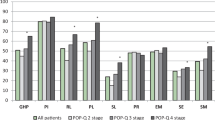Abstract
Introduction
This study aimed to translate and validate the P-QOL questionnaire in the Malay language.
Methods
The P-QOL questionnaire was translated into the Malay language and subsequently back-translated to English. Test-retest reliability and internal consistency were tested. All patients who visited the gynecology outpatient clinic of UKMMC, UMMC and IIUM between January 2016 and May 2017 completed the P-QOL questionnaires and were assessed for POP-Q staging.
Results
One hundred twenty patients with symptomatic pelvic organ prolapse and 180 asymptomatic patients were included. The Cronbach’s alpha for each domain was > 0.70, which confirmed that there was a highly acceptable internal consistency. The value varied between 0.88 (role limitation) and 0.912 (sleep/energy). Test-retest reliability showed a significant correlation between the total scores for each domain (p < 0.001). There was a significant correlation between P-QOL domain scores and vaginal examination findings (POP-Q). With a higher POP-Q stage, a higher impact on the quality of life was detected in symptomatic patients. The total scores from all domains were significantly higher in symptomatic patients.
Conclusion
The Malay translated version of the P-QOL questionnaire is a reliable, consistent, and valid instrument for assessing the severity of the symptoms and impact on the quality of life among women with uterovaginal prolapse. It is easily understood, administered, and self-completed by patients.
Similar content being viewed by others
References
Samuelsson EC, Arne Victor FT, Tibblin G, et al. Sign of genital prolapsed in a Swedish population of women 20 to 59 years of age and possible related factors. American Journal of Obstetrics Gynecology. 1999;180:299–305.
MacLennan AH, Taylor AW, Wilson DH, et al. The prevalence of pelvic floor disorders and their relationship to gender, age, parity and mode of delivery. International Journal of Obstetrics Gynaecology. 2000;107(12):1460–70.
Veit-Rubin N, Cartwright R, Singh AU, et al. Association between joint hypermobility and pelvic organ prolapse in women: a systematic review and meta-analysis. Int Urogynecol J. 2016;27(10):1469–78.
Barber MD, Maher C. Epidemiology and outcome assessment of pelvic organ prolapse. Int Urogynecol J. 2013;24:1783.
Swift SE, Tate SB, Nicholas J. Correlation of symptoms with degree of pelvic organ support in a general population of women: what is pelvic organ prolapsed? American Journal of Obstetrics Gynecology. 2003;189:372–9.
Digesu GA, Khullar V, Cardozo L, et al. P-QOL: a validated questionnaire to assess the symptoms and quality of life of women with urogenital prolapsed. Int Urogynecol J. 2005;16:176–81.
Digesu GA, Santamato S, Khullar V, et al. Validation of an Italian version of the prolapsed quality of life questionnaire. European Journal of Obstetrics and Gynecology and Reproductive Biology. 2003;106:184–92.
Veit-Rubin N, Digesu A, Swift S, et al. Validation of the French version of the P-QoL questionnaire. European Journal of Obstetrics and Gynecology and Reproductive Biology. 2015;192:10–6.
Cam C, Sakalli M, Ay P, et al. Validation of the prolapsed quality of life questionnaire (P-QOL) in a Turkish population. European Journal of Obstetrics and Gynecology and Reproductive Biology. 2007;135:132–5.
Lenz F, Stammer H, Brocker K, et al. Validation of a German version of the P-QOL questionnaire. Int Urogynecol J. 2009;20:641–9.
de Oliveira MS, Tamanini JT, de Aguiar CG. Validation of the prolapsed quality-of-life questionnaire (P-QOL) in Portuguese version in Brazilian women. Int Urogynecol J. 2009;20:1191–202.
Fukumoto Y, Uesaka Y, Yamamoto K, et al. Assessment of quality of life in women with pelvic organ prolapsed: conditional translation and trial of P-QoL for use in Japan. Nippon Hinyokika Gakkai Zasshi. 2008;99(3):531–42.
Claerhout F, Moons P, Ghesquiere S, et al. Validity, reliability and responsiveness of a Dutch version of the prolapsed quality-of-life (P-QoL) questionnaire. Int Urogynecol J. 2010;21:569–78.
Svihrova V, Digesu GA, Svhira J, et al. Validation of the Slovakian version of the P-QOL questionnaire. Int Urogynecol J. 2010;21:53–61.
Manchana T, Bunyavejchevin S. Validation of the prolapse quality of life (P-QOL) questionnaire in Thai version. Int Urogynecol J. 2010;21:985–93.
Toozs-Hobson P, Freeman R, Barber M, et al. An international Urogynecological association (IUGA)/international continence society (ICS) joint report on the terminology for reporting outcomes of surgical procedures for pelvic organ prolapse. Int Urogynecol J. 2012;23:527–35.
Ismail R, Ismail R. Pelvic organ prolapse in women attending menopause clinic: prevalence and risk factors. Malaysian Journal of Obstetrics & Gynaecology. 2008;15:86–92.
Leslie K. Survey sampling. New York: John Wiley and Sons Inc.; 1965.
Bump RC. The POP-Q system: two decades of progress and debate. Int Urogynecol J. 2014;25:441–3.
Fayyad A, Hill S, Gurung V, et al. How accurate is symptomatic and clinical evaluation of prolapsed prior to surgical repair? International Urogynaecology Journal. 2007;18:1179–83.
Acknowledgments
The authors thank the O&G Department of University Malaya Medical Center, Associate Prof. Dr. Su-Yen Khong and the O&G Department of the International Islamic University of Malaysia, and Associate Prof. Dr. Zalina Nusee for their contributions. This study was presented at 25th Congress of the Obstetrical and Gynecology Society of Malaysia and was awarded Best Poster Presentation (Gynecology).
Funding
This study was unfunded.
Author information
Authors and Affiliations
Contributions
Rima Anggrena Dasrilsyah, Beng Kwang Ng, Ixora Kamisan, Su-Yen Khong, and Zalina Nusee were involved in data collection; analysis and interpretation; manuscript writing. Pei Shan Lim contributed to the conception of this study, data analysis and interpretation, manuscript writing, and revising it critically. All authors critically revised the first draft and approved the final version.
Corresponding author
Ethics declarations
Details of ethics approval
The study was approved by the University ethical committee of University Kebangsaan Malaysia (code: FF-2016-069).
Conflicts of interest
None.
Additional information
Publisher’s note
Springer Nature remains neutral with regard to jurisdictional claims in published maps and institutional affiliations.
Electronic supplementary material
ESM 1
(DOCX 31 kb)
Rights and permissions
About this article
Cite this article
Dasrilsyah, R.A., Ng, B.K., Atan, I.K. et al. Validation of the Malay version of the p-QOL questionnaire. Int Urogynecol J 32, 3163–3167 (2021). https://doi.org/10.1007/s00192-020-04362-w
Received:
Accepted:
Published:
Issue Date:
DOI: https://doi.org/10.1007/s00192-020-04362-w




